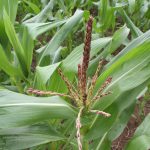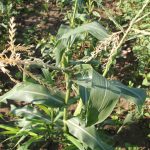Twenty-five of the 35 sites reporting this week. European corn borer (ECB)-E was trapped at five sites and ECB-Z was trapped at ten sites. Corn earworm (CEW) was trapped at seventeen sites, with fifteen sites high enough to be on a 4, 5 or 6 day spray schedule (see chart below). Fall armyworm (FAW) was caught at one site and Western bean cutworm (WBC) was caught at four sites this week.
Today, while scouting a field, I observed damaged tassels where ECB had already bored into the stems. Additionally, I found tassels within the whorl containing hidden ECB larvae. Timing spray applications is crucial to effectively target the larvae after they leave the tassel but before they bore into the plant.
Larvae feeding in the whorl are protected from insecticide applications and mortality will not be as high as at tassel emergence, when larvae feeding in the emerging tassel are exposed to the spray. Larvae will leave the tassel as it opens up and no longer provides a moist, protected feeding environment, and move down the plant looking for protected places to feed. Insecticide applications need to be timed to kill larvae before they bore into a new feeding location where again they will be protected from sprays. In fields with very uneven development, two applications may be necessary, one when approximately 25-50% of the tassels have emerged, and again after 75-100% of the tassels have emerged, if the field is still over threshold.
- Tassel too early
- Well timed
- Tassel too late
If the map is not visible and you are using Firefox as your browser, be sure to turn off enhanced tracking by going to the blue shield icon to the left of the URL address bar.






